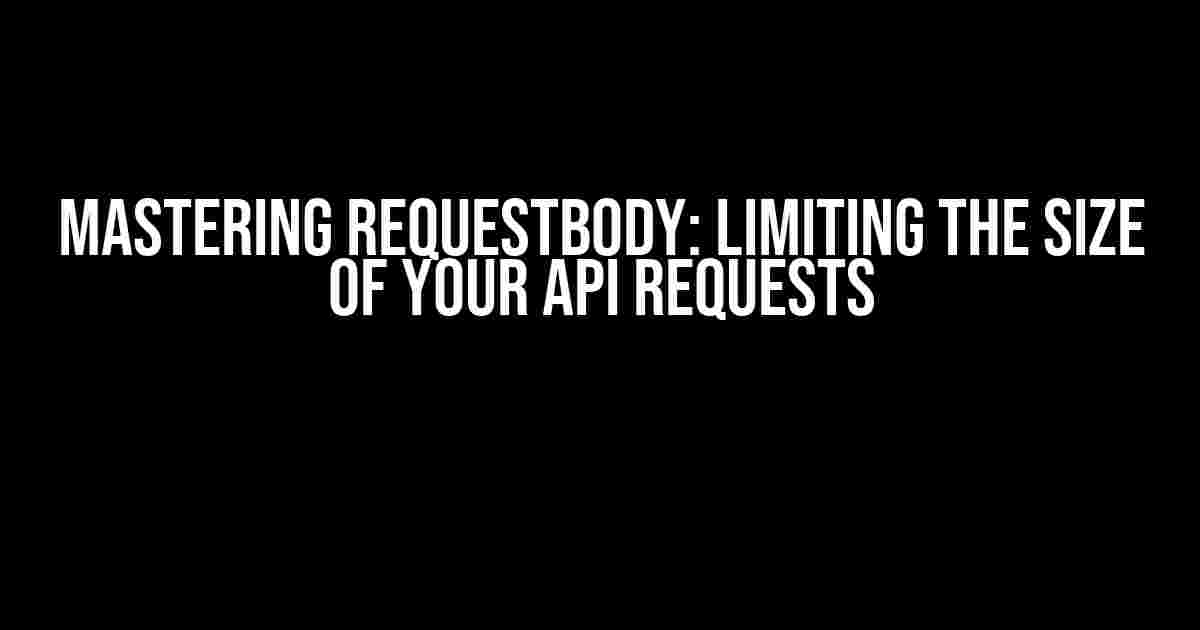When building robust and efficient APIs, one crucial aspect to consider is the size of the RequestBody. Unchecked, large request bodies can lead to performance issues, increased latency, and even crashes. In this article, we’ll delve into the world of RequestBody size limitation, exploring the reasons behind it, the consequences of neglecting it, and most importantly, the practical steps to implement it.
Why Limit the Size of RequestBody?
Before we dive into the how, let’s examine the reasons why limiting the size of a RequestBody is essential:
- Performance Optimization: Large request bodies can consume significant server resources, leading to slow response times and decreased performance.
- Security: Unrestricted request bodies can be vulnerable to attacks, such as buffer overflow attacks or Denial-of-Service (DoS) attacks.
- Data Integrity: Large request bodies can lead to data corruption or loss during transmission, compromising data integrity.
The Consequences of Unchecked RequestBody Size
Neglecting to limit the size of RequestBody can have severe consequences, including:
- Performance Degradation: Large request bodies can cause increased latency, slow response times, and even server crashes.
- Security Breaches: Unrestricted request bodies can be exploited by attackers, leading to data breaches and system compromise.
- Data Loss: Large request bodies can result in data corruption or loss during transmission, compromising data integrity.
Setting Up RequestBody Size Limitation
Now that we’ve covered the importance and consequences of unchecked RequestBody size, let’s get to the practical steps to implement size limitation:
Using the `@RequestBody` Annotation
In Spring-based applications, you can use the `@RequestBody` annotation to specify the maximum size of the request body:
@RestController
public class MyController {
@PostMapping("/api endpoint")
public String myMethod(@RequestBody(maxSize = 1024) MyRequest request) {
// process request
}
}
In this example, the `maxSize` attribute is set to 1024 bytes, limiting the request body size to 1 KB.
Configuring the `HttpMessageConverter`
You can also configure the `HttpMessageConverter` to set the maximum request body size:
@Configuration
public class WebConfig extends WebMvcConfigurerAdapter {
@Override
public void configureMessageConverters(List> converters) {
// Create a new converter with the desired max size
GsonHttpMessageConverter converter = new GsonHttpMessageConverter();
converter.setMaxBytesPerRead(1024);
converters.add(converter);
}
}
In this example, the `maxBytesPerRead` attribute is set to 1024 bytes, limiting the request body size to 1 KB.
Using a Servlet Filter
You can also use a servlet filter to limit the request body size:
public class RequestBodySizeFilter implements Filter {
@Override
public void doFilter(ServletRequest req, ServletResponse res, FilterChain chain) throws IOException, ServletException {
HttpServletRequest request = (HttpServletRequest) req;
int maxSize = 1024;
if (request.getContentLength() > maxSize) {
throw new ServletException("Request body size exceeds the maximum allowed size");
}
chain.doFilter(req, res);
}
}
In this example, the filter checks the content length of the request and throws an exception if it exceeds the specified maximum size.
Best Practices for RequestBody Size Limitation
To ensure effective RequestBody size limitation, follow these best practices:
| Best Practice | Description |
|---|---|
| Set a reasonable maximum size | Set a maximum size that balances performance and security requirements. |
| Use a consistent approach | Apply the same size limitation approach throughout your API to ensure consistency. |
| Document the limitation | Clearly document the request body size limitation in your API documentation to inform clients. |
| Handle errors gracefully | Implement error handling mechanisms to handle cases where the request body size exceeds the maximum allowed size. |
Conclusion
In conclusion, limiting the size of a RequestBody is a crucial aspect of building robust and efficient APIs. By understanding the reasons behind it, the consequences of neglecting it, and the practical steps to implement it, you can ensure the security, performance, and data integrity of your API. Remember to follow best practices and document the limitation to inform clients. Happy coding!
By mastering RequestBody size limitation, you’ll be well on your way to building APIs that are fast, secure, and reliable. Stay tuned for more articles on API development and optimization!
Here are 5 Questions and Answers about “Limiting the size of a RequestBody” in HTML format:
Frequently Asked Question
Get answers to your questions about limiting the size of a RequestBody!
What is the default limit for the size of a RequestBody?
The default limit for the size of a RequestBody is typically 2MB, but this can vary depending on the framework, library, or service being used. For example, in ASP.NET Core, the default limit is 28.6 MB, while in Node.js with Express.js, it’s 1MB.
Why is it important to limit the size of a RequestBody?
Limiting the size of a RequestBody is crucial to prevent Denial of Service (DoS) attacks, reduce memory usage, and improve performance. Large request bodies can cause servers to become unresponsive or crash, allowing attackers to exploit vulnerabilities.
How can I increase the limit for the size of a RequestBody?
You can increase the limit by configuring the relevant settings in your framework, library, or service. For example, in ASP.NET Core, you can set the `MaxRequestBodySize` property, while in Node.js with Express.js, you can use the `limit` option when creating a middleware.
What happens when a RequestBody exceeds the size limit?
When a RequestBody exceeds the size limit, the server will typically return a 413 “Payload Too Large” status code. This indicates to the client that the request was refused due to its size, and the client may need to retry with a smaller payload.
Can I set different size limits for different endpoints?
Yes, you can set different size limits for different endpoints by configuring the settings at the endpoint or controller level. This allows you to fine-tune the size limits based on the specific requirements of each endpoint.







